A Review of Earth Observation-Based Drought Studies in Southeast Asia
Abstract
1. Introduction
1.1. Drought Relevance
1.2. Impacts of Drought in Southeast Asia
1.3. The Potential of the EO-Based Analysis of Droughts
1.4. Scope and Purpose of the Review
2. Materials and Methods
3. Results
3.1. Current Progress and Trends of Drought Studies in Southeast Asia
3.1.1. Temporal Progress and the Journal of Drought Publications
3.1.2. Spatial Distribution and Authorship of the Drought Publications
3.1.3. Temporal Resolution of the Drought Publications
3.1.4. Spatial Scale, Resolution and Drought Validations
3.1.5. Satellite Sensors and Categories
3.1.6. Remote Sensing-Derived Input Variables and Drought Indices
3.2. The EO Applications in Drought Analysis
3.2.1. Soil Moisture and Crop Stress
3.2.2. Vegetation Stress
3.2.3. Drought-Related Forest Fires
3.2.4. Variability in the Terrestrial Water Storage and Streamflow
3.2.5. Drought-Induced Land-Use Change
3.2.6. Meteorological Droughts
4. Discussion
4.1. Discrepancy of Drought Publications among Southeast Asian Countries
4.2. Evaluation of Drought Products and Mapping Duration
4.3. A Need for Higher Spatial and Temporal Resolutions
5. Conclusions
- (1)
- The number of drought publications has increased over the past 21 years, with a total of 102 articles, and especially in the last 5 years (which accounted for 80%). However, nearly 65% of the articles were conducted in mainland Southeast Asia, and Vietnam is the most active destination of drought studies (35 articles). In addition, more than 50% of the corresponding authors are affiliated with non-Southeast Asian academic institutions. we expect that these collaboration links may boost drought research capacity and lead to more publications in the coming years.
- (2)
- Nearly 50% of the articles employed optical remote sensing, whereas the microwave remote sensing of drought received the fewest applications. The combined use of Landsat and Sentinel data has not yet been explored for drought monitoring. Newer satellite missions such as SMAP and its downscaling products should be investigated in the region because of their high spatiotemporal resolution for soil moisture drought.
- (3)
- Most of the studies focused on single vegetation-based and/or precipitation-based drought indices (~53%). There are new opportunities for developing combined drought approaches. In addition, machine learning has been rarely applied in drought detection. Further efforts are needed in order to enhance drought prediction for early warning and mitigation planning.
- (4)
- Several articles did not report the accuracy information on drought mapping products (~22%), whereas precipitation was the main source of data for validating drought maps (46%). In addition, time-series drought remote sensing witnessed an increase in recent years, but longer time-series drought measurements (e.g., >30 years) are limited (~90%). Future endeavors on multi-sensor data fusion/reconstruction are necessary in order to produce longer time-series drought observations.
- (5)
- There is an associated relationship between the spatial resolution and the study area extent. The larger the study area is, the coarser the spatial resolution of the map produced. It can also be observed that more than half of the articles focused on drought monitoring at a local scale, and 64% of digital drought maps were produced at a spatial resolution of 1 km and above. Given the increasing cloud-based computing platforms (e.g., Google Earth Engine), there will be more opportunities for regional and transboundary drought assessment.
- (6)
- There are large discrepancies among drought-specific applications in the region. Although agricultural drought was the most frequently reported application (~58%), soil moisture and crop-specific drought monitoring are still limited. Because Southeast Asia is one of the biggest agricultural producers worldwide, we call for more attention to soil moisture and crop-specific drought assessment, in addition to hydrological and meteorological observations.
Author Contributions
Funding
Data Availability Statement
Conflicts of Interest
References
- Esfahanian, E.; Nejadhashemi, A.P.; Abouali, M.; Adhikari, U.; Zhang, Z.; Daneshvar, F.; Herman, M.R. Development and evaluation of a comprehensive drought index. J. Environ. Manag. 2017, 185, 31–43. [Google Scholar] [CrossRef]
- Erian, W.; Pulwarty, R.; Vogt, J.; AbuZeid, K.; Bert, F.; Bruntrup, M.; El-Askary, H.; de Estrada, M.; Gaupp, F.; Grundy, M. GAR Special Report on Drought 2021; United Nations Office for Disaster Risk Reduction: Geneva, Switzerland, 2021. [Google Scholar]
- FAO. Food Price Monitoring and Analysis Bulletin; FAO: Rome, Italy, 2017. [Google Scholar]
- IPCC. Climate Change 2022: Impacts, Adaptation, and Vulnerability; Contribution of Working Group II to the Sixth Assessment Report of the Intergovernmental Panel on Climate Change; Pörtner, H., Roberts, D., Tignor, M., Poloczanska, E., Mintenbeck, K., Alegría, A., Craig, M., Langsdorf, S., Löschke, S., Rama, B., et al., Eds.; Cambridge University Press: Cambridge, UK, 2022; in press; Available online: https://www.ipcc.ch/report/ar6/wg2 (accessed on 25 July 2022).
- Zhao, J.; Zhang, Q.; Zhu, X.; Shen, Z.; Yu, H. Drought risk assessment in China: Evaluation framework and influencing factors. Geogr. Sustain. 2020, 1, 220–228. [Google Scholar] [CrossRef]
- Shi, J.; Cui, L.; Tian, Z. Spatial and temporal distribution and trend in flood and drought disasters in East China. Environ. Res. 2020, 185, 109406. [Google Scholar] [CrossRef] [PubMed]
- Samphantharak, K. Natural disasters and the economy: Some recent experiences from Southeast Asia. Asian-Pac. Econ. Lit. 2014, 28, 33–51. [Google Scholar] [CrossRef]
- Chen, X.; Liu, H.; Mu, X. Summary of Flood and Drought in Mekong River Basin, in Flood Prevention and Drought Relief in Mekong River Basin; Springer: Berlin/Heidelberg, Germany, 2020; pp. 27–54. [Google Scholar]
- Thurman, M. Natural Disaster Risks in Central Asia: A Synthesis; United Nations Development Programme: Bratislava, Slovakia, 2011. [Google Scholar]
- Pollner, J.; Kryspin-Watson, J.; Nieuwejaar, S. Disaster Risk Management and Climate Change Adaptation in Europe and Central Asia; World Bank: Washington, DC, USA, 2010. [Google Scholar]
- Miyan, M.A. Droughts in Asian least developed countries: Vulnerability and sustainability. Weather Clim. Extrem. 2015, 7, 8–23. [Google Scholar] [CrossRef]
- Amnuaylojaroen, T.; Chanvichit, P. Projection of near-future climate change and agricultural drought in Mainland Southeast Asia under RCP8.5. Clim. Change 2019, 155, 175–193. [Google Scholar] [CrossRef]
- IPCC. 2022: Summary for Policymakers. In Climate Change 2022: Impacts, Adaptation, and Vulnerability; Contribution of Working Group II to the Sixth Assessment Report of the Intergovernmental Panel on Climate Change; Pörtner, H., Roberts, D., Tignor, M., Poloczanska, E., Mintenbeck, K., Alegría, A., Craig, M., Langsdorf, S., Löschke, S., Rama, B., et al., Eds.; Cambridge University Press: Cambridge, UK, 2022. [Google Scholar]
- Prodhan, F.A.; Zhang, J.; Sharma, T.P.P.; Nanzad, L.; Zhang, D.; Seka, A.M.; Ahmed, N.; Hasan, S.S.; Hoque, M.Z.; Mohana, H.P. Projection of future drought and its impact on simulated crop yield over South Asia using ensemble machine learning approach. Sci. Total Environ. 2022, 807, 151029. [Google Scholar] [CrossRef] [PubMed]
- Chen, L.; Wang, G.; Miao, L.; Gnyawali, K.R.; Li, S.; Amankwah, S.O.Y.; Huang, J.; Lu, J.; Zhan, M. Future drought in CMIP6 projections and the socioeconomic impacts in China. Int. J. Climatol. 2021, 41, 4151–4170. [Google Scholar] [CrossRef]
- Wilhite, A.D.; Glantz, M.H. Understanding: The drought phenomenon: The role of definitions. Water Int. 1985, 10, 111–120. [Google Scholar] [CrossRef]
- Wilhite, D. Drought Monitoring and Early Warning: Concepts, Progress and Future Challenges; WMO No. 1006; World Meteorological Organization (WMO): Geneva, Switzerland, 2006. [Google Scholar]
- Dracup, J.A.; Lee, K.S.; Paulson, E.G., Jr. On the definition of droughts. Water Resour. Res. 1980, 16, 297–302. [Google Scholar] [CrossRef]
- Svoboda, D.M.; Fuchs, B.A. Handbook of Drought Indicators and Indices; World Meteorological Organization: Geneva, Switzerland, 2016. [Google Scholar]
- Zhou, K.; Li, J.; Zhang, T.; Kang, A. The use of combined soil moisture data to characterize agricultural drought conditions and the relationship among different drought types in China. Agric. Water Manag. 2021, 243, 106479. [Google Scholar] [CrossRef]
- Hao, Z.; Singh, V.P. Drought characterization from a multivariate perspective: A review. J. Hydrol. 2015, 527, 668–678. [Google Scholar] [CrossRef]
- Crausbay, S.D.; Ramirez, A.R.; Carter, S.L.; Cross, M.S.; Hall, K.R.; Bathke, D.J.; Betancourt, J.L.; Colt, S.; Cravens, A.E.; Dalton, M.S.; et al. Defining ecological drought for the twenty-first century. Bull. Am. Meteorol. Soc. 2017, 98, 2543–2550. [Google Scholar] [CrossRef]
- Patel, N.; Chopra, P.; Dadhwal, V. Analyzing spatial patterns of meteorological drought using standardized precipitation index. Meteorol. Appl. J. Forecast. Pract. Appl. Train. Tech. Model. 2007, 14, 329–336. [Google Scholar] [CrossRef]
- Łabędzki, L. Estimation of local drought frequency in central Poland using the standardized precipitation index SPI. Irrig. Drain. J. Int. Comm. Irrig. Drain. 2007, 56, 67–77. [Google Scholar] [CrossRef]
- Manatsa, D.; Mukwada, G.; Siziba, E.; Chinyanganya, T. Analysis of multidimensional aspects of agricultural droughts in Zimbabwe using the Standardized Precipitation Index (SPI). Theor. Appl. Climatol. 2010, 102, 287–305. [Google Scholar] [CrossRef]
- Mutert, E.; Fairhurst, T. Developments in rice production in Southeast Asia. Better Crops Int. 2002, 15, 12–17. [Google Scholar]
- Van der Eng, P. Productivity and comparative advantage in rice agriculture in South-East Asia since 1870. Asian Econ. J. 2004, 18, 345–370. [Google Scholar] [CrossRef]
- UNESCAP. Asia-Pacific Disaster Report 2019; UNESCAP: Bangkok, Thailand, 2019. [Google Scholar]
- Phan-Van, T.; Nguyen-Ngoc-Bich, P.; Ngo-Duc, T.; Vu-Minh, T.; Le, P.V.; Trinh-Tuan, L.; Nguyen-Thi, T.; Pham-Thanh, H.; Tran-Quang, D. Drought over Southeast Asia and its association with large-scale drivers. J. Clim. 2022, 35, 4959–4978. [Google Scholar] [CrossRef]
- Jiao, W.; Wang, L.; McCabe, M.F. Multi-sensor remote sensing for drought characterization: Current status, opportunities and a roadmap for the future. Remote Sens. Environ. 2021, 256, 112313. [Google Scholar] [CrossRef]
- AghaKouchak, A.; Farahmand, A.; Melton, F.; Teixeira, J.; Anderson, M.; Wardlow, B.D.; Hain, C. Remote sensing of drought: Progress, challenges and opportunities. Rev. Geophys. 2015, 53, 452–480. [Google Scholar] [CrossRef]
- Heumann, B.W. Satellite remote sensing of mangrove forests: Recent advances and future opportunities. Prog. Phys. Geogr. 2011, 35, 87–108. [Google Scholar] [CrossRef]
- Sazib, N.; Mladenova, I.; Bolten, J. Leveraging the google earth engine for drought assessment using global soil moisture data. Remote Sens. 2018, 10, 1265. [Google Scholar] [CrossRef]
- Venkatappa, M.; Sasaki, N.; Han, P.; Abe, I. Impacts of droughts and floods on croplands and crop production in Southeast Asia–An application of Google Earth Engine. Sci. Total Environ. 2021, 795, 148829. [Google Scholar] [CrossRef]
- Khan, R.; Gilani, H. Global drought monitoring with drought severity index (DSI) using Google Earth Engine. Theor. Appl. Climatol. 2021, 146, 411–427. [Google Scholar] [CrossRef]
- Tran, T.; Tran, D.; Huynh, P.; Dao, H.; Vo, T.; Trinh, H.; Tran, X. Analysing Drought Intensity in the Mekong River Delta using Time Series Analysis and Google Earth Engine. Int. J. Geoinform. 2020, 16, 1–7. [Google Scholar]
- Zhao, X.; Xia, H.; Pan, L.; Song, H.; Niu, W.; Wang, R.; Li, R.; Bian, X.; Guo, Y.; Qin, Y. Drought monitoring over Yellow River basin from 2003–2019 using reconstructed MODIS land surface temperature in Google Earth Engine. Remote Sens. 2021, 13, 3748. [Google Scholar] [CrossRef]
- West, H.; Quinn, N.; Horswell, M. Remote sensing for drought monitoring & impact assessment: Progress, past challenges and future opportunities. Remote Sens. Environ. 2019, 232, 111291. [Google Scholar]
- Chandrasekara, S.S.; Kwon, H.-H.; Vithanage, M.; Obeysekera, J.; Kim, T.-W. Drought in South Asia: A review of drought assessment and prediction in South Asian countries. Atmosphere 2021, 12, 369. [Google Scholar] [CrossRef]
- Barlow, M.; Zaitchik, B.; Paz, S.; Black, E.; Evans, J.; Hoell, A. A review of drought in the Middle East and southwest Asia. J. Clim. 2016, 29, 8547–8574. [Google Scholar] [CrossRef]
- Zhang, L.; Zhou, T. Drought over East Asia: A review. J. Clim. 2015, 28, 3375–3399. [Google Scholar] [CrossRef]
- Zhu, J.; Liu, W.J.S. A tale of two databases: The use of Web of Science and Scopus in academic papers. Scientometrics 2020, 123, 321–335. [Google Scholar] [CrossRef]
- Clauss, K.; Ottinger, M.; Leinenkugel, P.; Kuenzer, C. Estimating rice production in the Mekong Delta, Vietnam, utilizing time series of Sentinel-1 SAR data. Int. J. Appl. Earth Obs. Geoinform. 2018, 73, 574–585. [Google Scholar] [CrossRef]
- UNESCAP. Ready for the Dry Years: Building Resilience to Drought in South-East Asia; UNESCAP: Bangkok, Thailand, 2021. [Google Scholar]
- Tsubo, M.; Fukai, S.; Basnayake, J.; Ouk, M. Frequency of occurrence of various drought types and its impact on performance of photoperiod-sensitive and insensitive rice genotypes in rainfed lowland conditions in Cambodia. Field Crops Res. 2009, 113, 287–296. [Google Scholar] [CrossRef]
- Perez, P.G.J.; Comiso, J.C. Seasonal and interannual variabilities of Philippine vegetation as seen from space. Philipp. J. Sci. 2014, 143, 147–155. [Google Scholar]
- Inoubli, R.; Abbes, A.B.; Farah, I.R.; Singh, V.; Tadesse, T.; Sattari, M.T. A Review of Drought Monitoring Using Remote Sensing and Data Mining Methods. In Proceedings of the 2020 5th International Conference on Advanced Technologies for Signal and Image Processing (ATSIP), Sousse, Tunisia, 2–5 September 2020; IEEE: New York, NY, USA, 2020. [Google Scholar]
- Liu, P. A survey of remote-sensing big data. Front. Environ. Sci. 2015, 3, 45. [Google Scholar] [CrossRef]
- Setiawan, A.M.; Lee, W.S.; Rhee, J. Spatio-temporal characteristics of Indonesian drought related to El Niño events and its predictability using the multi-model ensemble. Int. J. Climatol. 2017, 37, 4700–4719. [Google Scholar] [CrossRef]
- Erasmi, S.; Propastin, P.; Kappas, M.; Panferov, O. Spatial patterns of NDVI variation over Indonesia and their relationship to ENSO warm events during the period 1982–2006. J. Clim. 2009, 22, 6612–6623. [Google Scholar] [CrossRef]
- Dandridge, C.; Fang, B.; Lakshmi, V. Downscaling of SMAP soil moisture in the lower mekong river basin. Water 2019, 12, 56. [Google Scholar] [CrossRef]
- Sriwongsitanon, N.; Gao, H.; Savenije, H.; Maekan, E.; Saengsawan, S.; Thianpopirug, S. The Normalized Difference Infrared Index (NDII) as a proxy for soil moisture storage in hydrological modelling. Hydrol. Earth Syst. Sci. Discuss. 2015, 12, 8419–8457. [Google Scholar]
- Raksapatcharawong, M.; Veerakachen, W. Development of drought risk analysis platform using multiple satellite sensors. GEOMATE J. 2019, 17, 62–69. [Google Scholar] [CrossRef]
- Son, T.N.; Thanh, B.X. Remotely sensed drought evaluation over rice cultivated areas in Cambodia during 2000 to 2019. Geocarto Int. 2020, 37, 1237–1255. [Google Scholar] [CrossRef]
- Chen, C.-F.; Son, N.-T.; Chang, L.-Y.; Chen, C.-C. Monitoring of soil moisture variability in relation to rice cropping systems in the Vietnamese Mekong Delta using MODIS data. Appl. Geogr. 2011, 31, 463–475. [Google Scholar] [CrossRef]
- Son, N.T.; Chen, C.; Chen, C.; Chang, L.; Minh, V.Q. Monitoring agricultural drought in the Lower Mekong Basin using MODIS NDVI and land surface temperature data. Int. J. Appl. Earth Obs. Geoinform. 2012, 18, 417–427. [Google Scholar] [CrossRef]
- Du, T.L.T.; Bui, D.D.; Nguyen, M.D.; Lee, H. Satellite-based, multi-indices for evaluation of agricultural droughts in a highly dynamic tropical catchment, Central Vietnam. Water 2018, 10, 659. [Google Scholar] [CrossRef]
- Luong, N.D.; Hiep, N.H.; Bui, T.H. Investigating the Spatio-Temporal Variation of Soil Moisture and Agricultural Drought towards Supporting Water Resources Management in the Red River Basin of Vietnam. Sustainability 2021, 13, 4926. [Google Scholar] [CrossRef]
- Abhishek, A.; Das, N.N.; Ines, A.V.; Andreadis, K.M.; Jayasinghe, S.; Granger, S.; Ellenburg, W.L.; Dutta, R.; Quyen, N.H.; Markert, A.M.; et al. Evaluating the impacts of drought on rice productivity over Cambodia in the Lower Mekong Basin. J. Hydrol. 2021, 599, 126291. [Google Scholar] [CrossRef]
- Zheng, C.; Jia, L.; Hu, G.; Lu, J. Earth observations-based evapotranspiration in Northeastern Thailand. Remote Sens. 2019, 11, 138. [Google Scholar] [CrossRef]
- Sa-Nguansilp, C.; Wijitkosum, S.; Sriprachote, A. Agricultural drought risk assessment in Lam Ta Kong watershed, Thailand. Int. J. Geoinform. 2017, 13, 37–43. [Google Scholar]
- Raksapatcharawong, M.; Veerakachen, W.; Homma, K.; Maki, M.; Oki, K. Satellite-based drought impact assessment on rice yield in Thailand with SIMRIW–RS. Remote Sens. 2020, 12, 2099. [Google Scholar] [CrossRef]
- Perez, G.; Macapagal, M.; Olivares, R.; Macapagal, E.; Comiso, J. Forecasting and Monitoring Agricultural Drought in the Philippines. Int. Arch. Photogramm. Remote Sens. Spat. Inf. Sci. 2016, 41, 1263–1269. [Google Scholar] [CrossRef]
- Amalo, L.F.; Hidayat, R.; Sulma, S. Analysis of agricultural drought in east java using vegetation health index. AGRIVITA J. Agric. Sci. 2017, 40, 63–73. [Google Scholar] [CrossRef]
- Shashikant, V.; Shariff, A.R.M.; Wayayok, A.; Kamal, M.R.; Lee, Y.P.; Takeuchi, W. Utilizing TVDI and NDWI to Classify Severity of Agricultural Drought in Chuping, Malaysia. Agronomy 2021, 11, 1243. [Google Scholar] [CrossRef]
- Naeimi, V.; Leinenkugel, P.; Sabel, D.; Wagner, W.; Apel, H.; Kuenzer, C. Evaluation of soil moisture retrieval from the ERS and Metop scatterometers in the lower Mekong Basin. Remote Sens. 2013, 5, 1603–1623. [Google Scholar] [CrossRef]
- Parida, B.; Collado, W.; Borah, R.; Hazarika, M.; Samarakoon, L. Detecting drought-prone areas of rice agriculture using a MODIS-derived soil moisture index. GISci. Remote Sens. 2008, 45, 109–129. [Google Scholar] [CrossRef]
- Jordan, I.M.; Mitchell, T.M. Machine learning: Trends, perspectives, and prospects. Science 2015, 349, 255–260. [Google Scholar] [CrossRef]
- Qian, X.; Qiu, B.; Zhang, Y. Widespread decline in vegetation photosynthesis in Southeast Asia due to the prolonged drought during the 2015/2016 El Niño. Remote Sens. 2019, 11, 910. [Google Scholar] [CrossRef]
- Zhang, Y.; Zhu, Z.; Liu, Z.; Zeng, Z.; Ciais, P.; Huang, M.; Liu, Y.; Piao, S. Seasonal and interannual changes in vegetation activity of tropical forests in Southeast Asia. Agric. For. Meteorol. 2016, 224, 1–10. [Google Scholar] [CrossRef]
- Xie, F.; Fan, H. Deriving drought indices from MODIS vegetation indices (NDVI/EVI) and Land Surface Temperature (LST): Is data reconstruction necessary? Int. J. Appl. Earth Obs. Geoinform. 2021, 101, 102352. [Google Scholar] [CrossRef]
- Zhang, B.; Zhang, L.; Guo, H.; Leinenkugel, P.; Zhou, Y.; Li, L.; Shen, Q. Drought impact on vegetation productivity in the Lower Mekong Basin. Int. J. Remote Sens. 2014, 35, 2835–2856. [Google Scholar] [CrossRef]
- Karnieli, A.; Agam, N.; Pinker, R.T.; Anderson, M.; Imhoff, M.L.; Gutman, G.G.; Panov, N.; Goldberg, A. Use of NDVI and land surface temperature for drought assessment: Merits and limitations. J. Clim. 2010, 23, 618–633. [Google Scholar] [CrossRef]
- Laosuwan, T.; Sangpradid, S.; Gomasathit, T.; Rotjanakusol, T. Application of remote sensing technology for drought monitoring in Mahasarakham Province, Thailand. Int. J. Geoinform. 2016, 12, 17–25. [Google Scholar]
- Rotjanakusol, T.; Laosuwan, T. Remote Sensing Based Drought Monitoring in the Middle-Part of Northeast Region of Thailand. Studia Univ. Vasile Goldis Arad Ser. Stiintele Vietii 2018, 28, 14–21. [Google Scholar]
- Thavorntam, W.; Tantemsapya, N. Vegetation greenness modeling in response to climate change for Northeast. Thailand. J. Geogr. Sci. 2013, 23, 1052–1068. [Google Scholar] [CrossRef]
- Khampeera, A.; Yongchalermchai, C.; Techato, K. Drought monitoring using drought indices and GIS techniques in Kuan Kreng peat swamp, Southern Thailand. Walailak J. Sci. Technol. (WJST) 2018, 15, 357–370. [Google Scholar] [CrossRef]
- Uttaruk, Y.; Laosuwan, T. Drought detection by application of remote sensing technology and vegetation phenology. J. Ecol. Eng. 2017, 18, 115–121. [Google Scholar] [CrossRef]
- Rotjanakusol, T.; Laosuwan, T. An Investigation of Drought around Chi Watershed During Ten-Year Period Using Terra/Modis Data. Geogr. Tech. 2019, 14, 74–83. [Google Scholar] [CrossRef]
- Uttaruk, Y.; Laosuwan, T. Drought Analysis Using Satellite-Based Data and Spectral Index in Upper Northeastern Thailand. Pol. J. Environ. Stud. 2019, 28, 4447–4454. [Google Scholar] [CrossRef]
- Chokkuea, W. Spatial-temporal Change of Land Surface Temperature using Satellite Remote Sensing Data. Studia Univ. Vasile Goldis Arad Ser. Stiintele Vietii (Life Sci. Ser.) 2019, 29, 65–69. [Google Scholar]
- Sangpradid, S.; Uttaruk, Y.; Rotjanakusol, T.; Laosuwan, T. Forecasting Time Series Change of the Average Enhanced Vegetation Index to Monitoring Drought Condition by Using Terra/Modis Data. Poljopr. Sumar. 2021, 67, 115–129. [Google Scholar] [CrossRef]
- Jomsrekrayom, N.; Meena, P.; Laosuwan, T. Spatiotemporal Analysis of Vegetation Drought Variability in the Middle of the Northeast Region of Thailand Using Terra/Modis Satellite Data. Geogr. Tech. 2021, 16, 70–81. [Google Scholar] [CrossRef]
- Rotjanakusol, T.; Laosuwan, T. Drought Evaluation with Ndvi-Based Standardized Vegetation Index in Lower Northeastern Region of Thailand. Geogr. Tech. 2019, 14, 118–130. [Google Scholar] [CrossRef]
- Thavorntam, W.; Tantemsapya, N.; Armstrong, L. A combination of meteorological and satellite-based drought indices in a better drought assessment and forecasting in Northeast Thailand. Nat. Hazards 2015, 77, 1453–1474. [Google Scholar] [CrossRef]
- Tran, H.T.; Campbell, J.B.; Tran, T.D.; Tran, H.T. Monitoring drought vulnerability using multispectral indices observed from sequential remote sensing (Case Study: Tuy Phong, Binh Thuan, Vietnam). GISci. Remote Sens. 2017, 54, 167–184. [Google Scholar] [CrossRef]
- Dang, T.; Yue, P.; Bachofer, F.; Wang, M.; Zhang, M. Monitoring Land Surface Temperature Change with Landsat Images during Dry Seasons in Bac Binh, Vietnam. Remote Sens. 2020, 12, 4067. [Google Scholar] [CrossRef]
- Tran, T.V.; Tran, D.X.; Myint, S.W.; Huang, C.-y.; Pham, H.V.; Luu, T.H.; Vo, T.M. Examining spatiotemporal salinity dynamics in the Mekong River Delta using Landsat time series imagery and a spatial regression approach. Sci. Total Environ. 2019, 687, 1087–1097. [Google Scholar] [CrossRef]
- Boyd, D.; Phipps, P.; Foody, G.; Walsh, R. Exploring the utility of NOAA AVHRR middle infrared reflectance to monitor the impacts of ENSO-induced drought stress on Sabah rainforests. Int. J. Remote Sens. 2002, 23, 5141–5147. [Google Scholar] [CrossRef]
- Boyd, D.; Foody, G.; Phipps, P. Dynamics of ENSO drought events on Sabah rainforests observed by NOAA AVHRR. Int. J. Remote Sens. 2006, 27, 2197–2219. [Google Scholar] [CrossRef]
- Razali, S.M.; Atucha, A.A.M.; Nuruddin, A.A.; Hamid, H.A.; Shafri, H.Z.M. Monitoring vegetation drought using MODIS remote sensing indices for natural forest and plantation areas. J. Spat. Sci. 2016, 61, 157–172. [Google Scholar] [CrossRef]
- Couturier, S.; Taylor, D.; Siegert, F.; Hoffmann, A.; Bao, M. ERS SAR backscatter: A potential real-time indicator of the proneness of modified rainforests to fire. Remote Sens. Environ. 2001, 76, 410–417. [Google Scholar] [CrossRef]
- Prasetyo, S.Y.J.; Hartomo, K.D.; Paseleng, M.C. Satellite imagery and machine learning for identification of aridity risk in central Java Indonesia. PeerJ Comput. Sci. 2021, 7, e415. [Google Scholar] [CrossRef]
- Prasetyo, S.Y.J.; Hartomo, K.D.; Paseleng, M.C.; Chandra, D.W.; Winarko, E. Satellite imagery and machine learning for aridity disaster classification using vegetation indices. Bull. Electr. Eng. Inform. 2020, 9, 1149–1158. [Google Scholar] [CrossRef][Green Version]
- Arjasakusuma, S.; Yamaguchi, Y.; Hirano, Y.; Zhou, X. ENSO-and rainfall-sensitive vegetation regions in Indonesia as identified from multi-sensor remote sensing data. ISPRS Int. J. Geo-Inf. 2018, 7, 103. [Google Scholar] [CrossRef]
- Vadrevu, K.P.; Lasko, K.; Giglio, L.; Schroeder, W.; Biswas, S.; Justice, C. Trends in vegetation fires in south and southeast Asian countries. Sci. Rep. 2019, 9, 7422. [Google Scholar] [CrossRef]
- Sastry, N. Forest fires, air pollution, and mortality in Southeast Asia. Demography 2002, 39, 1–23. [Google Scholar] [CrossRef]
- Fuller, D.O.; Jessup, T.C.; Salim, A. Loss of forest cover in Kalimantan, Indonesia, since the 1997–1998 El Nino. Conserv. Biol. 2004, 18, 249–254. [Google Scholar] [CrossRef]
- Gutman, G.; Csiszar, I.; Romanov, P. Using NOAA/AVHRR products to monitor El Nino impacts: Focus on Indonesia in 1997–1998. Bull. Am. Meteorol. Soc. 2000, 81, 1189–1206. [Google Scholar] [CrossRef]
- Miettinen, J.; Shi, C.; Liew, S.C. Fire distribution in Peninsular Malaysia, Sumatra and Borneo in 2015 with special emphasis on peatland fires. Environ. Manag. 2017, 60, 747–757. [Google Scholar] [CrossRef]
- Langner, A.; Siegert, F. Spatiotemporal fire occurrence in Borneo over a period of 10 years. Glob. Change Biol. 2009, 15, 48–62. [Google Scholar] [CrossRef]
- Parameswaran, K.; Nair, S.K.; Rajeev, K. Impact of Indonesian forest fires during the 1997 El Nino on the aerosol distribution over the Indian Ocean. Adv. Space Res. 2004, 33, 1098–1103. [Google Scholar] [CrossRef]
- Chart-asa, C. Spatial-temporal patterns of MODIS active fire/hotspots in Chiang Rai, upper northern Thailand and the greater mekong subregion countries during 2003–2015. Appl. Environ. Res. 2021, 43, 121–131. [Google Scholar] [CrossRef]
- Nurhayati, A.D.; Saharjo, B.H.; Sundawati, L.; Syartinilia, S.; Cochrane, M.A. Forest and Peatland Fire Dynamics in South Sumatra Province. For. Soc. 2021, 5, 591–603. [Google Scholar] [CrossRef]
- Noojipady, P.; Morton, D.C.; Schroeder, W.; Carlson, K.M.; Huang, C.; Gibbs, H.K.; Burns, D.; Walker, N.F.; Prince, S.D. Managing fire risk during drought: The influence of certification and El Niño on fire-driven forest conversion for oil palm in Southeast Asia. Earth Syst. Dyn. 2017, 8, 749–771. [Google Scholar] [CrossRef]
- Siegert, F.; Ruecker, G.; Hinrichs, A.; Hoffmann, A. Increased damage from fires in logged forests during droughts caused by El Nino. Nature 2001, 414, 437–440. [Google Scholar] [CrossRef]
- Wooster, M.; Perry, G.; Zoumas, A. Fire, drought and El Niño relationships on Borneo (Southeast Asia) in the pre-MODIS era (1980–2000). Biogeosciences 2012, 9, 317–340. [Google Scholar] [CrossRef]
- Sloan, S.; Locatelli, B.; Wooster, M.J.; Gaveau, D.L. Fire activity in Borneo driven by industrial land conversion and drought during El Niño periods, 1982–2010. Glob. Environ. Change 2017, 47, 95–109. [Google Scholar] [CrossRef]
- Lohberger, S.; Stängel, M.; Atwood, E.C.; Siegert, F. Spatial evaluation of Indonesia’s 2015 fire-affected area and estimated carbon emissions using Sentinel-1. Glob. Change Biol. 2018, 24, 644–654. [Google Scholar] [CrossRef]
- Fanin, T.; van der Werf, G.R. Precipitation—Fire linkages in Indonesia (1997–2015). Biogeosciences 2017, 14, 3995–4008. [Google Scholar] [CrossRef]
- Hidayat, H.; Teuling, A.J.; Vermeulen, B.; Taufik, M.; Kastner, K.; Geertsema, T.J.; Bol, D.C.; Hoekman, D.H.; Haryani, G.S.; Van Lanen, H.A.; et al. Hydrology of inland tropical lowlands: The Kapuas and Mahakam wetlands. Hydrol. Earth Syst. Sci. 2017, 21, 2579–2594. [Google Scholar] [CrossRef]
- Mohammed, I.N.; Bolten, J.D.; Srinivasan, R.; Lakshmi, V. Satellite observations and modeling to understand the Lower Mekong River Basin streamflow variability. J. Hydrol. 2018, 564, 559–573. [Google Scholar] [CrossRef]
- Frappart, F.; Biancamaria, S.; Normandin, C.; Blarel, F.; Bourrel, L.; Aumont, M.; Azemar, P.; Vu, P.-L.; Le Toan, T.; Lubac, B.; et al. Influence of recent climatic events on the surface water storage of the Tonle Sap Lake. Sci. Total Environ. 2018, 636, 1520–1533. [Google Scholar] [CrossRef]
- Aires, F.; Venot, J.-P.; Massuel, S.; Gratiot, N.; Pham-Duc, B.; Prigent, C. Surface water evolution (2001–2017) at the Cambodia/Vietnam border in the upper mekong delta using satellite MODIS observations. Remote Sens. 2020, 12, 800. [Google Scholar] [CrossRef]
- Pham-Duc, B.; Papa, F.; Prigent, C.; Aires, F.; Biancamaria, S.; Frappart, F. Variations of surface and subsurface water storage in the Lower Mekong Basin (Vietnam and Cambodia) from multisatellite observations. Water 2019, 11, 75. [Google Scholar] [CrossRef]
- Soulard, C.E.; Walker, J.J.; Petrakis, R.E. Implementation of a surface water extent model in Cambodia using cloud-based remote sensing. Remote Sens. 2020, 12, 984. [Google Scholar] [CrossRef]
- Tanaka, M.; Sugimura, T.; Tanaka, S.; Tamai, N. Flood–drought cycle of Tonle Sap and Mekong Delta area observed by DMSP-SSM/I. Int. J. Remote Sens. 2003, 24, 1487–1504. [Google Scholar] [CrossRef]
- Erban, E.L.; Gorelick, S.M. Closing the irrigation deficit in Cambodia: Implications for transboundary impacts on groundwater and Mekong River flow. J. Hydrol. 2016, 535, 85–92. [Google Scholar] [CrossRef]
- Gu, Z.; Zhang, Y.; Fan, H. Mapping inter-and intra-annual dynamics in water surface area of the Tonle Sap Lake with Landsat time-series and water level data. J. Hydrol. 2021, 601, 126644. [Google Scholar] [CrossRef]
- Hashim, M.; Reba, N.M.; Nadzri, M.I.; Pour, A.B.; Mahmud, M.R.; Yusoff, A.R.M.; Ali, M.I.; Jaw, S.; Hossain, M.S. Satellite-based run-off model for monitoring drought in Peninsular Malaysia. Remote Sens. 2016, 8, 633. [Google Scholar] [CrossRef]
- Fok, H.S.; He, Q.; Chun, K.P.; Zhou, Z.; Chu, T. Application of ENSO and drought indices for water level reconstruction and prediction: A case study in the lower Mekong River estuary. Water 2018, 10, 58. [Google Scholar] [CrossRef]
- Le, M.-H.; Lakshmi, V.; Bolten, J.; Du Bui, D. Adequacy of satellite-derived precipitation estimate for hydrological modeling in Vietnam Basins. J. Hydrol. 2020, 586, 124820. [Google Scholar] [CrossRef]
- Jing, W.; Zhao, X.; Yao, L.; Jiang, H.; Xu, J.; Yang, J.; Li, Y. Variations in terrestrial water storage in the Lancang-Mekong river basin from GRACE solutions and land surface model. J. Hydrol. 2020, 580, 124258. [Google Scholar] [CrossRef]
- Mariano, D.A.; dos Santos, C.A.; Wardlow, B.D.; Anderson, M.C.; Schiltmeyer, A.V.; Tadesse, T.; Svoboda, M.D. Use of remote sensing indicators to assess effects of drought and human-induced land degradation on ecosystem health in Northeastern Brazil. Remote Sens. Environ. 2018, 213, 129–143. [Google Scholar] [CrossRef]
- Tangang, F.; Juneng, L.; Cruz, F.; Chung, J.X.; Ngai, S.T.; Salimun, E.; Mohd, M.S.F.; Santisirisomboon, J.; Singhruck, P.; PhanVan, T.; et al. Multi-model projections of precipitation extremes in Southeast Asia based on CORDEX-Southeast Asia simulations. Environ. Res. 2020, 184, 109350. [Google Scholar]
- Nita, I.; Putra, A.N.; Fibrianingtyas, A. Analysis of drought hazards in agricultural land in Pacitan Regency, Indonesia. SAINS TANAH-J. Soil Sci. Agroclimatol. 2020, 17, 7–15. [Google Scholar] [CrossRef]
- Hien, L.T.T.; Gobin, A.; Huong, P.T.T. Spatial indicators for desertification in southeast Vietnam. Nat. Hazards Earth Syst. Sci. 2019, 19, 2325–2337. [Google Scholar] [CrossRef]
- Thy, P.T.M.; Ngoc, T.H.T.; Truong, T.N.K.; Nguyen, L.-D.; Nguyen-Huy, T. Specifying the relationship between land use/land cover change and dryness in central Vietnam from 2000 to 2019 using Google Earth Engine. J. Appl. Remote Sens. 2021, 15, 024503. [Google Scholar]
- Tran, H.T.; Campbell, J.B.; Wynne, R.H.; Shao, Y.; Phan, S.V. Drought and human impacts on land use and land cover change in a Vietnamese coastal area. Remote Sens. 2019, 11, 333. [Google Scholar] [CrossRef]
- Phan, V.H.; Dinh, V.T.; Su, Z. Trends in long-term drought changes in the mekong river delta of Vietnam. Remote Sens. 2020, 12, 2974. [Google Scholar] [CrossRef]
- Tran, T.V.; Tran, D.X.; Myint, S.W.; Latorre-Carmona, P.; Ho, D.D.; Tran, P.H.; Dao, H.N. Assessing spatiotemporal drought dynamics and its related environmental issues in the mekong river delta. Remote Sens. 2019, 11, 2742. [Google Scholar] [CrossRef]
- Le, T.; Sun, C.; Choy, S.; Kuleshov, Y. Regional drought risk assessment in the Central Highlands and the South of Vietnam. Geomat. Nat. Hazards Risk 2021, 12, 3140–3159. [Google Scholar] [CrossRef]
- Le, M.-H.; Kim, H.; Moon, H.; Zhang, R.; Lakshmi, V.; Nguyen, L.-B. Assessment of drought conditions over Vietnam using standardized precipitation evapotranspiration index, MERRA-2 re-analysis, and dynamic land cover. J. Hydrol. Reg. Stud. 2020, 32, 100767. [Google Scholar] [CrossRef]
- Palmer, W.C. Meteorological Drought; US Department of Commerce, Weather Bureau: Washington, DC, USA, 1965; Volume 30.
- Tian, Y.; Peters-Lidard, C.D. A global map of uncertainties in satellite-based precipitation measurements. Geophys. Res. Lett. 2010, 37, L24407. [Google Scholar] [CrossRef]
- Sun, Q.; Miao, C.; Duan, Q.; Ashouri, H.; Sorooshian, S.; Hsu, K.L. A review of global precipitation data sets: Data sources, estimation, and intercomparisons. Rev. Geophys. 2018, 56, 79–107. [Google Scholar] [CrossRef]
- Vu, T.M.; Raghavan, S.V.; Liong, S.Y.; Mishra, A.K. Uncertainties of gridded precipitation observations in characterizing spatio-temporal drought and wetness over Vietnam. Int. J. Climatol. 2018, 38, 2067–2081. [Google Scholar] [CrossRef]
- Kuswanto, H.; Naufal, A. Evaluation of performance of drought prediction in Indonesia based on TRMM and MERRA-2 using machine learning methods. MethodsX 2019, 6, 1238–1251. [Google Scholar] [CrossRef]
- Vernimmen, R.; Hooijer, A.; Aldrian, E.; Van Dijk, A. Evaluation and bias correction of satellite rainfall data for drought monitoring in Indonesia. Hydrol. Earth Syst. Sci. 2012, 16, 133–146. [Google Scholar] [CrossRef]
- Tan, M.L.; Chua, V.P.; Tan, K.C.; Brindha, K. Evaluation of TMPA 3B43 and NCEP-CFSR precipitation products in drought monitoring over Singapore. Int. J. Remote Sens. 2018, 39, 2089–2104. [Google Scholar] [CrossRef]
- Tan, M.L.; Tan, K.C.; Chua, V.P.; Chan, N.W. Evaluation of TRMM product for monitoring drought in the Kelantan River Basin, Malaysia. Water 2017, 9, 57. [Google Scholar] [CrossRef]
- Zad, S.N.M.; Zulkafli, Z.; Muharram, F.M. Satellite rainfall (TRMM 3B42-V7) performance assessment and adjustment over Pahang River Basin, Malaysia. Remote Sens. 2018, 10, 388. [Google Scholar]
- Chu, H.-J.; Wijayanti, R.F.; Jaelani, L.M.; Tsai, H.-P. Time Varying Spatial Downscaling of Satellite-Based Drought Index. Remote Sens. 2021, 13, 3693. [Google Scholar] [CrossRef]
- Gerke, S.; Evers, H.-D. Globalizing local knowledge: Social science research on Southeast Asia, 1970–2000. SOJOURN—J. Soc. Issues Southeast Asia 2006, 21, 1–21. [Google Scholar] [CrossRef]
- UNESCAP. ASEAN Regional Plan of Action for Adaptation to Drought 2021–2025; UNESCAP: Bangkok, Thailand, 2021. [Google Scholar]
- Cammalleri, C.; Arias-Muñoz, C.; Barbosa, P.; de Jager, A.; Magni, D.; Masante, D.; Mazzeschi, M.; McCormick, N.; Naumann, G.; Spinoni, J.; et al. A revision of the Combined Drought Indicator (CDI) used in the European Drought Observatory (EDO). Nat. Hazards Earth Syst. Sci. 2021, 21, 481–495. [Google Scholar] [CrossRef]
- Del Pilar Jiménez-Donaire, M.; Tarquis, A.; Giráldez, J.V. Evaluation of a combined drought indicator and its potential for agricultural drought prediction in southern Spain. Nat. Hazards Earth Syst. Sci. 2020, 20, 21–33. [Google Scholar] [CrossRef]
- Bayissa, Y.A.; Tadesse, T.; Svoboda, M.; Wardlow, B.; Poulsen, C.; Swigart, J.; Van Andel, S.J. Developing a satellite-based combined drought indicator to monitor agricultural drought: A case study for Ethiopia. GISci. Remote Sens. 2019, 56, 718–748. [Google Scholar] [CrossRef]
- Sepulcre-Canto, G.; Horion, S.; Singleton, A.; Carrao, H.; Vogt, J. Development of a Combined Drought Indicator to detect agricultural drought in Europe. Nat. Hazards Earth Syst. Sci. 2012, 12, 3519–3531. [Google Scholar] [CrossRef]
- Otkin, J.A.; Svoboda, M.; Hunt, E.D.; Ford, T.W.; Anderson, M.C.; Hain, C.; Basara, J.B. Flash droughts: A review and assessment of the challenges imposed by rapid-onset droughts in the United States. Bull. Am. Meteorol. Soc. 2018, 99, 911–919. [Google Scholar] [CrossRef]
- Lu, J.; Jia, L.; Menenti, M.; Yan, Y.; Zheng, C.; Zhou, J. Performance of the standardized precipitation index based on the TMPA and CMORPH precipitation products for drought monitoring in China. IEEE J. Sel. Top. Appl. Earth Obs. Remote Sens. 2018, 11, 1387–1396. [Google Scholar] [CrossRef]
- Vrieling, A. Satellite remote sensing for water erosion assessment: A review. Catena 2006, 65, 2–18. [Google Scholar] [CrossRef]
- Avitabile, V.; Herold, M.; Henry, M.; Schmullius, C. Mapping biomass with remote sensing: A comparison of methods for the case study of Uganda. Carbon Balance Manag. 2011, 6, 7. [Google Scholar] [CrossRef]
- Priya, S.; Shibasaki, R. National spatial crop yield simulation using GIS-based crop production model. Ecol. Model. 2001, 136, 113–129. [Google Scholar] [CrossRef]
- Lai, C.; Zhong, R.; Wang, Z.; Wu, X.; Chen, X.; Wang, P.; Lian, Y. Monitoring hydrological drought using long-term satellite-based precipitation data. Sci. Total Environ. 2019, 649, 1198–1208. [Google Scholar] [CrossRef] [PubMed]
- Li, P.; Feng, Z.; Xiao, C. Acquisition probability differences in cloud coverage of the available Landsat observations over mainland Southeast Asia from 1986 to 2015. Int. J. Digit. Earth 2018, 11, 437–450. [Google Scholar] [CrossRef]
- Nguyen, M.D.; Baez-Villanueva, O.M.; Bui, D.D.; Nguyen, P.T.; Ribbe, L. Harmonization of landsat and sentinel 2 for crop monitoring in drought prone areas: Case studies of Ninh Thuan (Vietnam) and Bekaa (Lebanon). Remote Sens. 2020, 12, 281. [Google Scholar] [CrossRef]
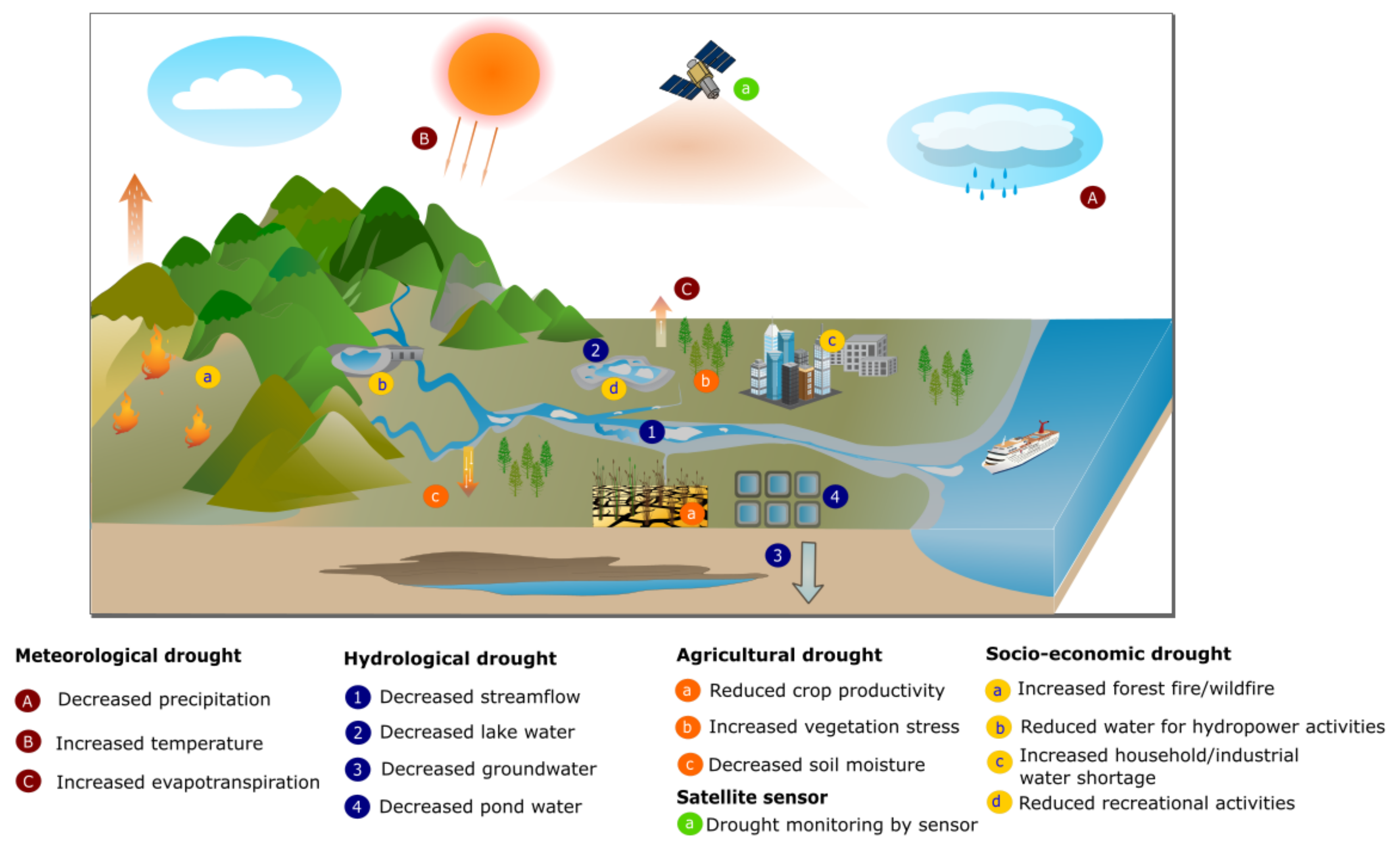

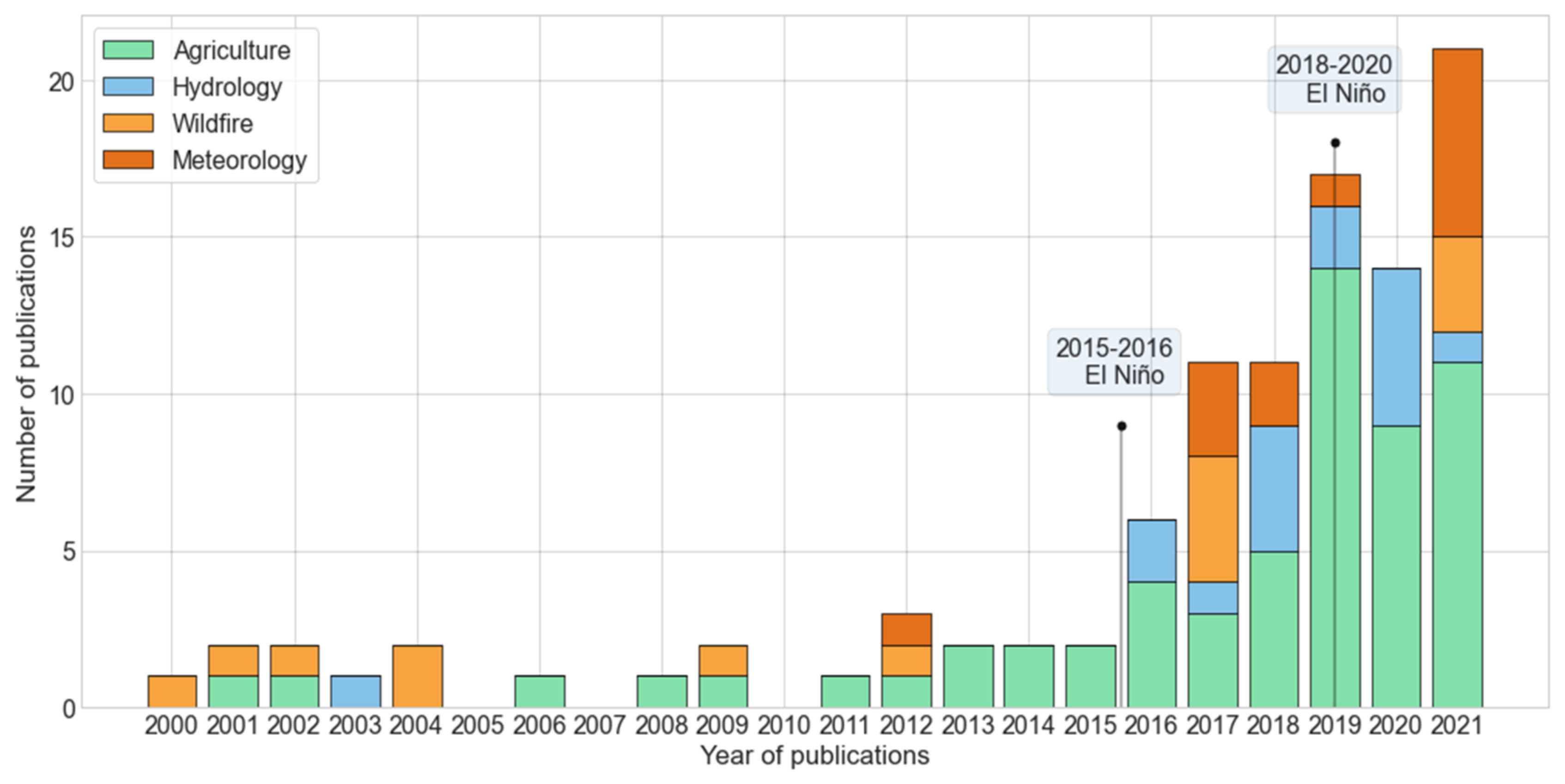
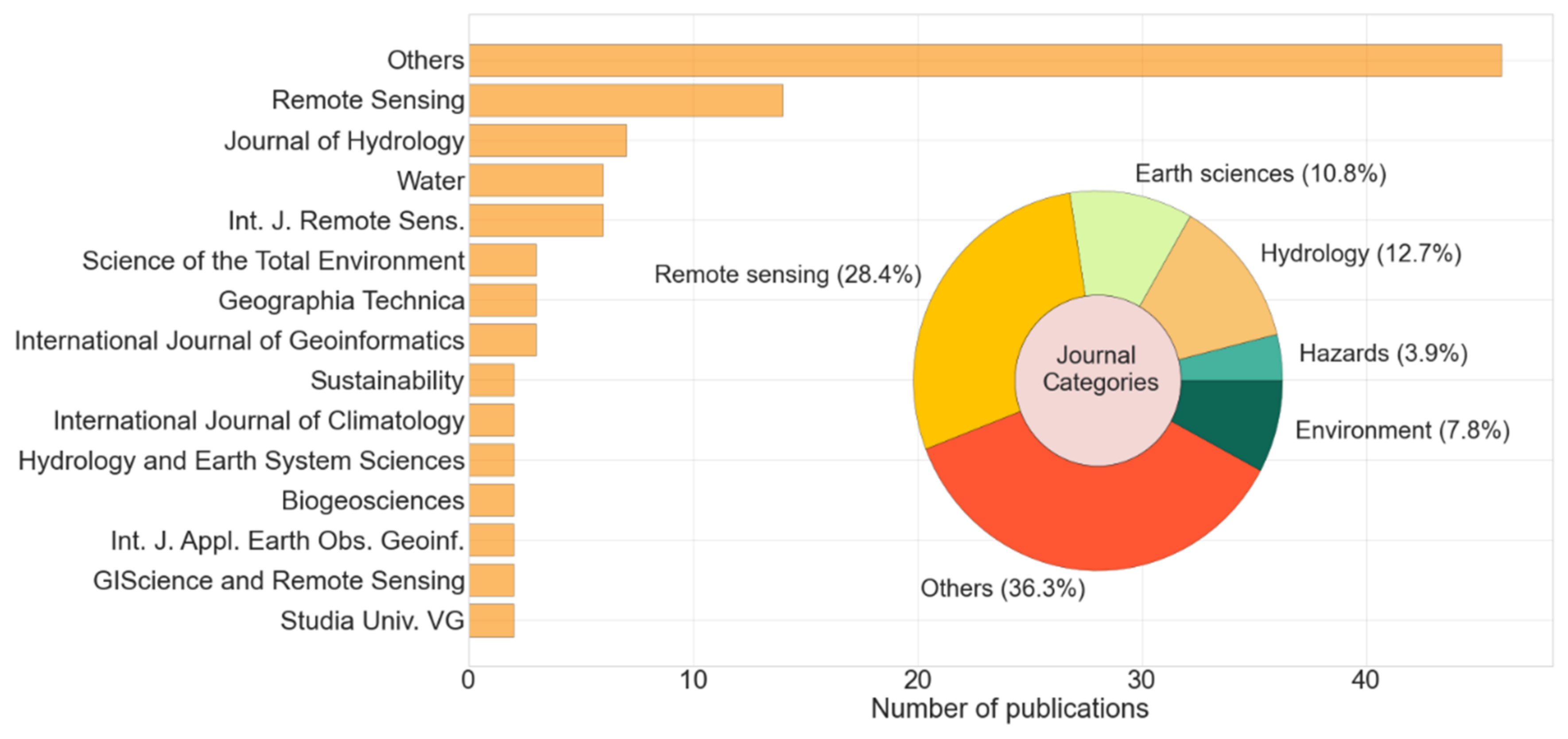
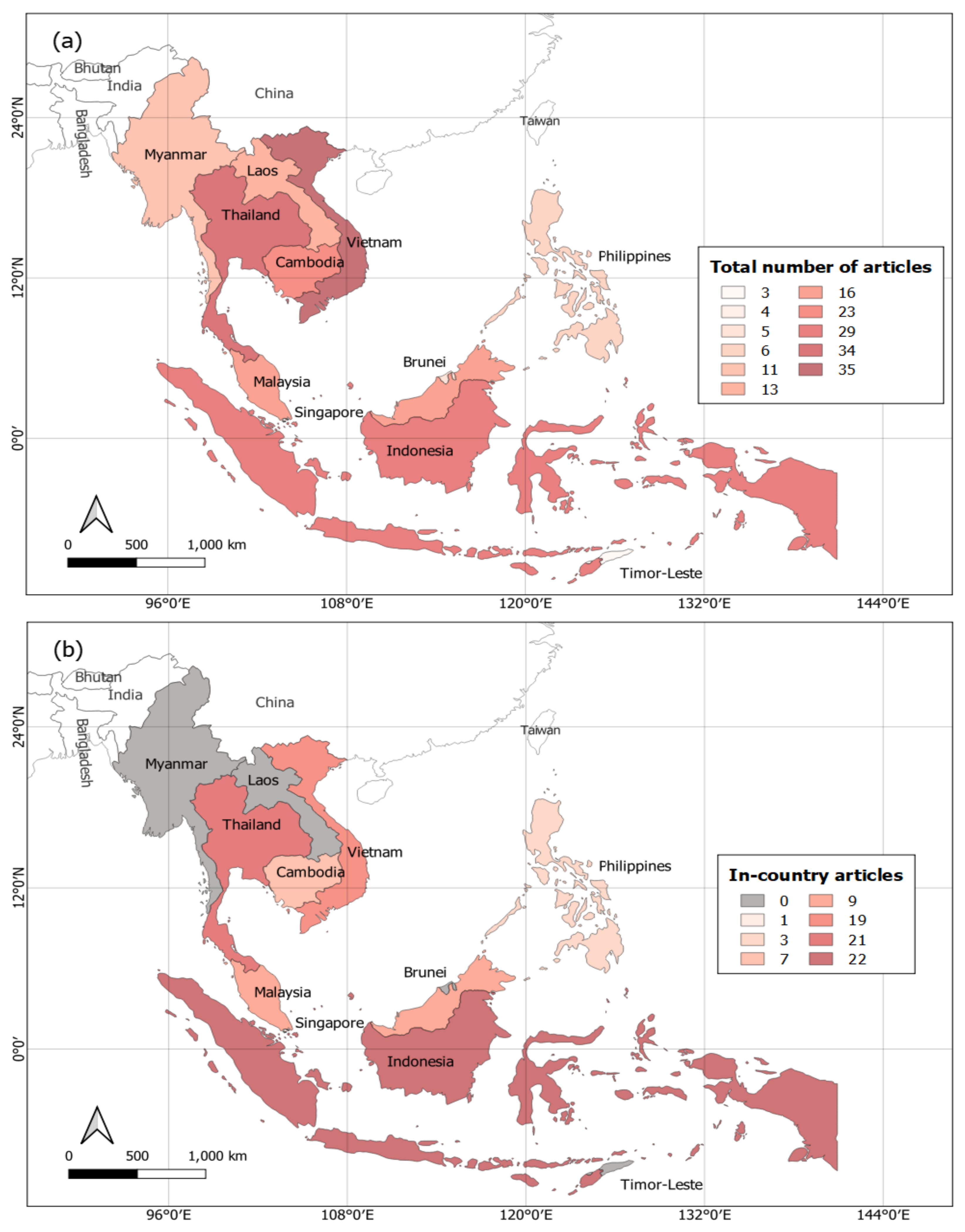

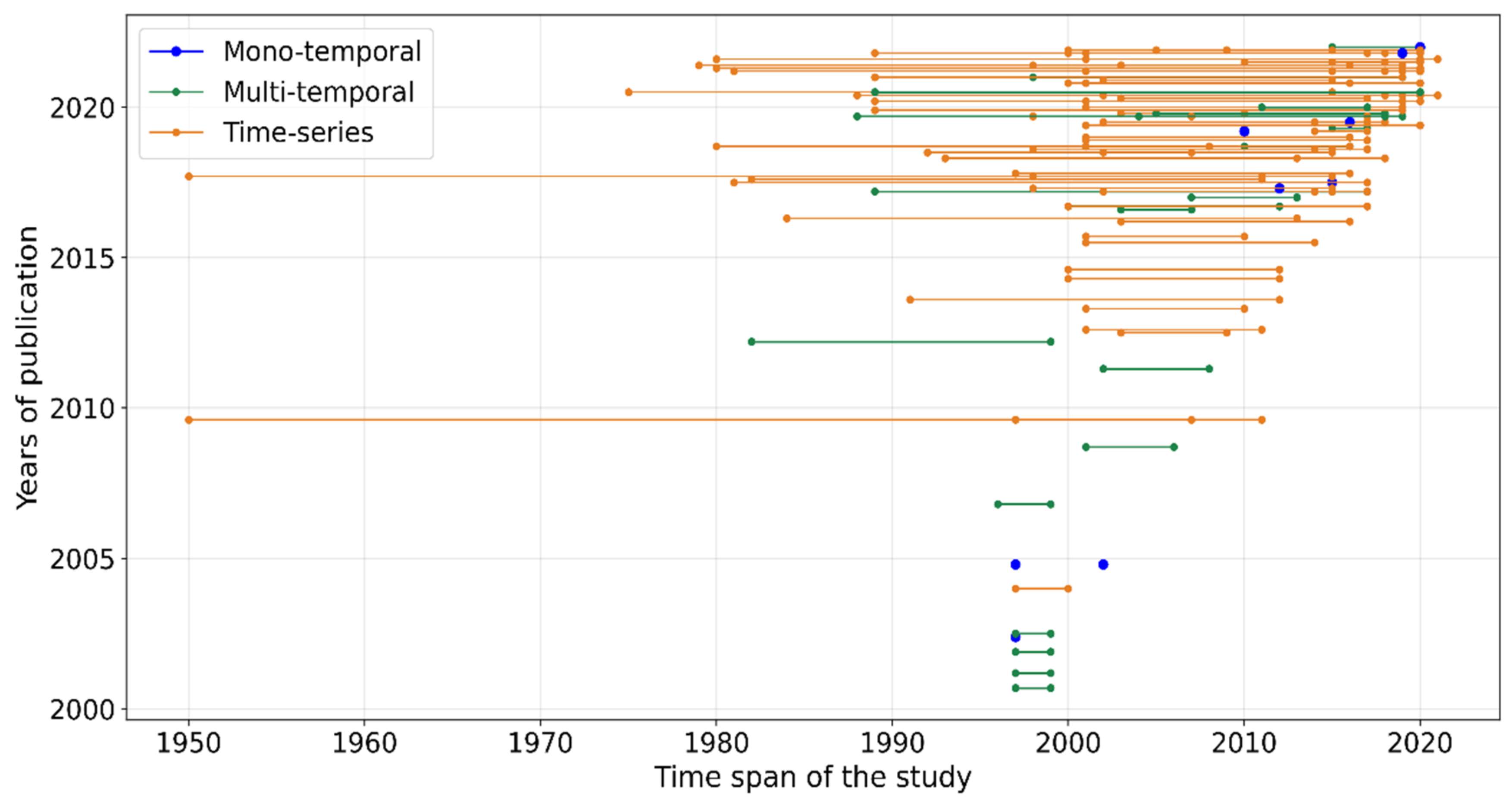
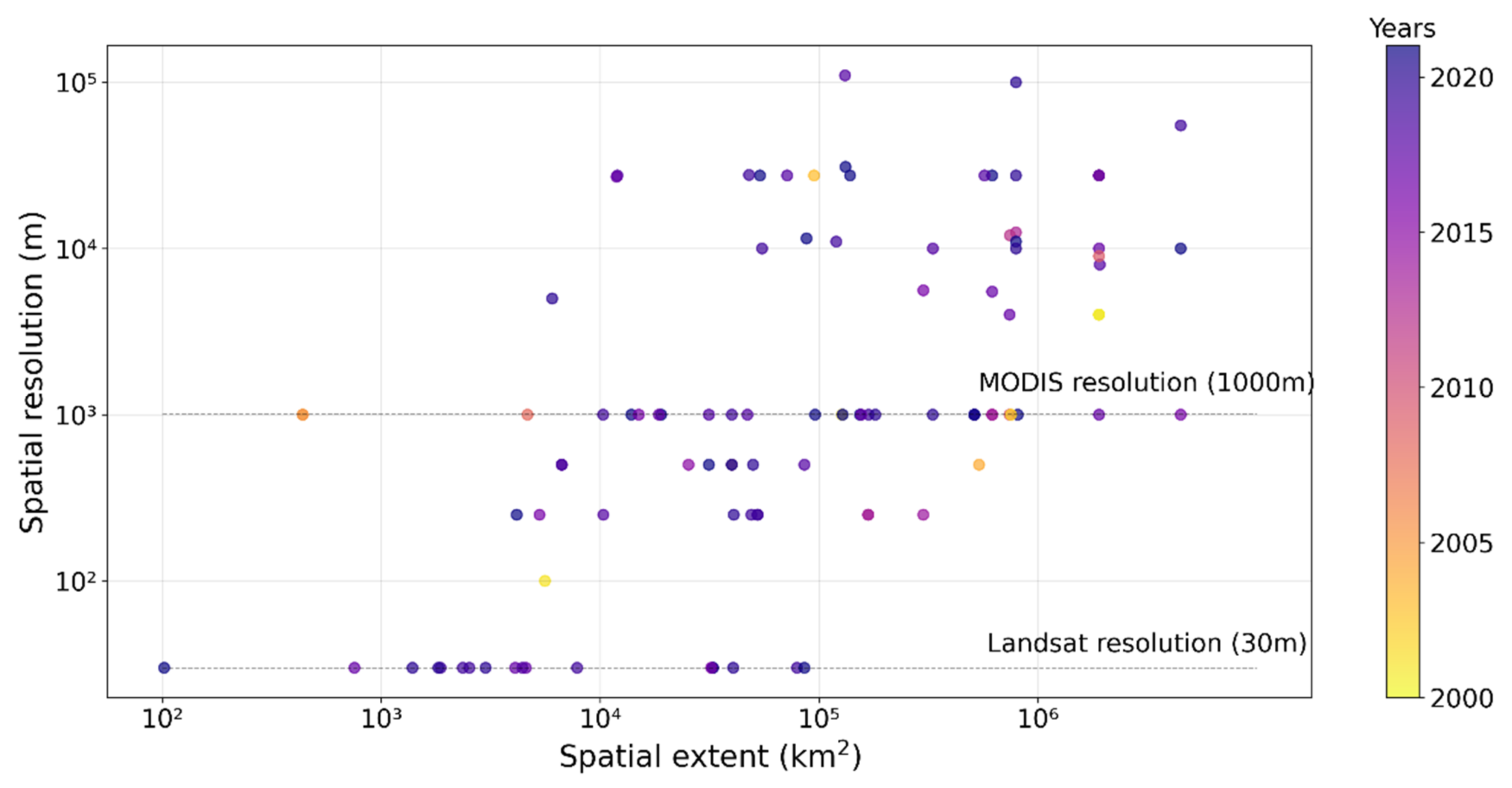


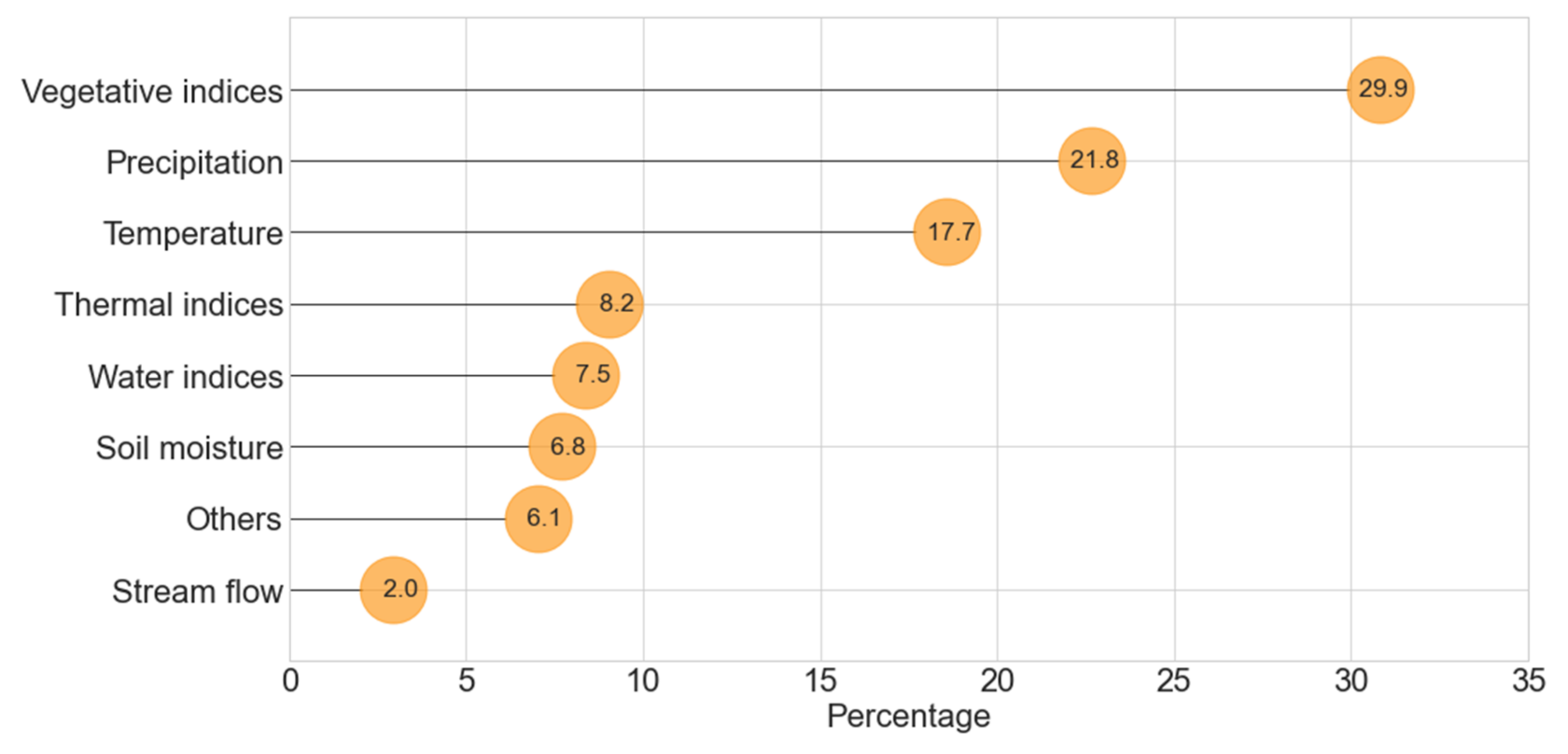

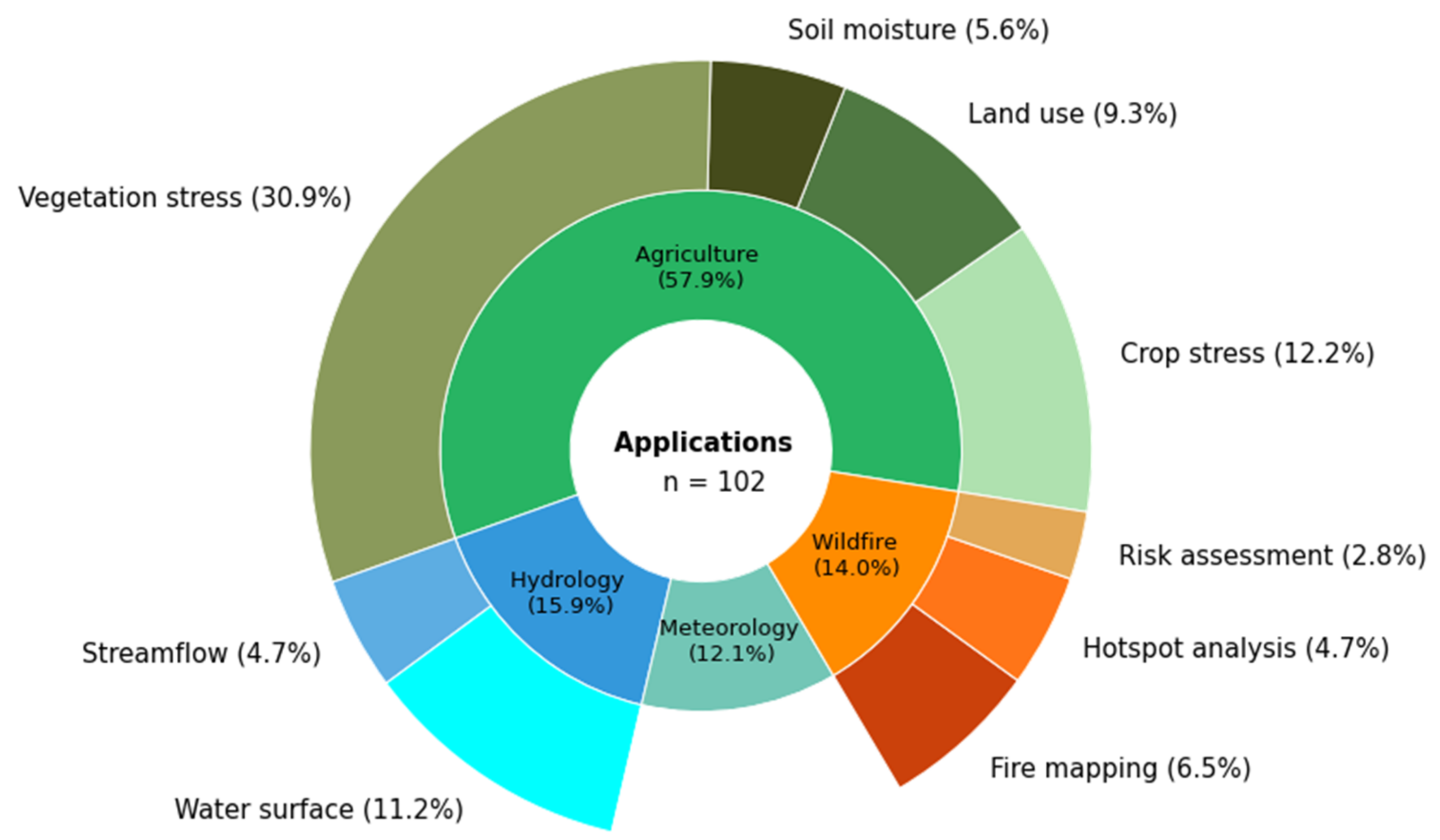
| Country | Drought Year | Associated Consequences | No. of Deaths | No. of Affected People | No. of Homeless | Cost (×103 USD) | No. of Events |
|---|---|---|---|---|---|---|---|
| Indonesia | 1966, 1972, 1978, 1982, 1984, 1986, 1987, 1991, 1994, 1997, 1998, 1999, 2000, 2002, 2003, 2005, 2006, 2015, 2019 | Epidemic, Wildfire, Cold wave, Storm, Famine, Pollution | 9790 | 8,246,535 | 0 | 17,468,124 | 22 |
| Laos | 1977, 1987, 1988, 1991, 1999, 2019 | - | 0 | 4,250,000 | 0 | 1990 | 6 |
| Philippines | 1978, 1980, 1983, 1985, 1987, 1990, 1998, 2000, 2002, 2007, 2015, 2019 | - | 371 | 5,749,094 | 0 | 299,899 | 14 |
| Myanmar | 1979, 1981, 2018 | - | 25 | 58,588 | 20 000 | 41,070 | 3 |
| Cambodia | 1987, 1994, 2001, 2002, 2005, 2016 | - | 0 | 9,050,000 | 0 | 240,054 | 6 |
| Vietnam | 1987, 1997, 1999, 2002, 2005, 2015, 2019 | Food shortage, Water shortage | 0 | 8,545,558 | 0 | 8,763,728 | 8 |
| Malaysia | 1993, 1995, 1997, 1998, 2005, 2014 | Pollution | 72 | 2,205,000 | 3000 | 509,758 | 7 |
| Thailand | 1991, 1993, 1999, 2002, 2005, 2008, 2010, 2011, 2012, 2014, 2015, 2016, 2019 | Pollution | 77 | 42,982,602 | 0 | 4,364,113 | 15 |
| Brunei | 1998 | - | 0 | 0 | 0 | 3325 | 1 |
| Timor-Leste | 2007, 2016 | - | 0 | 120,000 | 0 | 0 | 2 |
| Total | 10335 | 81,207,377 | 23,000 | 31,622,061 | 84 |
| Variables Recorded |
|---|
| Article code; Authors; Article title; Publication year; Journals; Journal categories; Corresponding authors’ country; Study country; Spatial scale a; Spatial extent (km2); Spatial resolution (m); Validation strategies b; Validation data; Drought indices; Remote sensing-derived input variable categories; Drought types c; Drought applications; Satellite sensors; Remote sensing categories d; Datasets; Temporal resolution e; Starting year of investigation, Ending year of investigation; Length of study; Notes. |
Publisher’s Note: MDPI stays neutral with regard to jurisdictional claims in published maps and institutional affiliations. |
© 2022 by the authors. Licensee MDPI, Basel, Switzerland. This article is an open access article distributed under the terms and conditions of the Creative Commons Attribution (CC BY) license (https://creativecommons.org/licenses/by/4.0/).
Share and Cite
Ha, T.V.; Huth, J.; Bachofer, F.; Kuenzer, C. A Review of Earth Observation-Based Drought Studies in Southeast Asia. Remote Sens. 2022, 14, 3763. https://doi.org/10.3390/rs14153763
Ha TV, Huth J, Bachofer F, Kuenzer C. A Review of Earth Observation-Based Drought Studies in Southeast Asia. Remote Sensing. 2022; 14(15):3763. https://doi.org/10.3390/rs14153763
Chicago/Turabian StyleHa, Tuyen V., Juliane Huth, Felix Bachofer, and Claudia Kuenzer. 2022. "A Review of Earth Observation-Based Drought Studies in Southeast Asia" Remote Sensing 14, no. 15: 3763. https://doi.org/10.3390/rs14153763
APA StyleHa, T. V., Huth, J., Bachofer, F., & Kuenzer, C. (2022). A Review of Earth Observation-Based Drought Studies in Southeast Asia. Remote Sensing, 14(15), 3763. https://doi.org/10.3390/rs14153763







